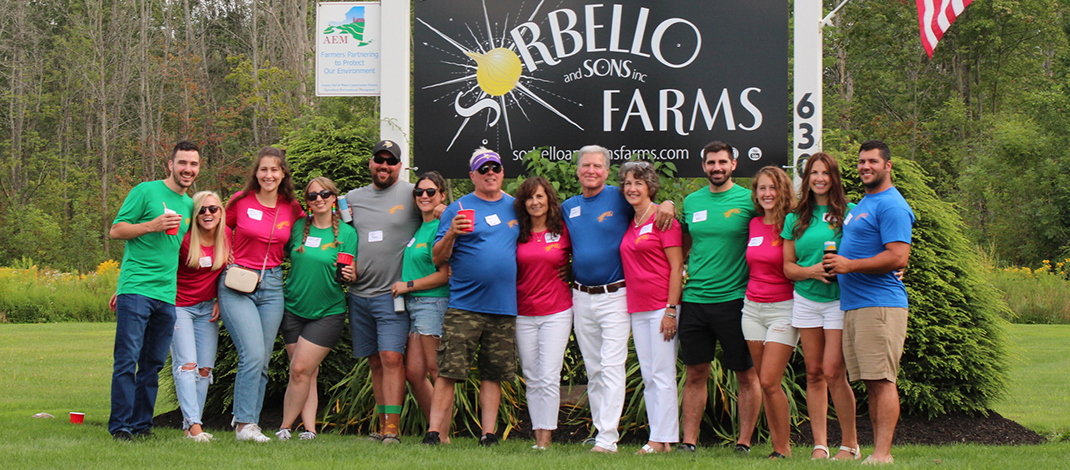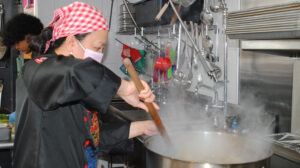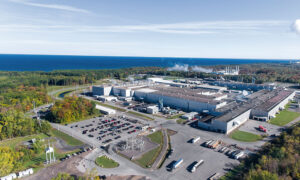The farm has been run by the Sorbello family since 1923
By Stefan Yablonski

Mariano Sorbello planted more than just seeds in Fulton 101 years ago. And even a devastating fire in 2013 couldn’t uproot his legacy.
Today Sorbello and Sons is a true family farm — 4.5 generations strong — embarking on its second hundred years.
Mariano grew hardy, pungent, northern yellow onions that could store all winter. In 1971, he handed the business to his son, Morris.
Together with his twin sons, David and Dana, Morris increased the farm to approximately 70 acres.
Morris left the farm in 1980, retiring a few years ago. His sons bought him out and the third generation took over.
Dana is president and David is the vice president.
In 1988, they formed Sorbello and Sons, Inc.
It has expanded to include both owners’ wives, David’s sons, Dylan and Rane, who tend to the daily operations of the growing and processing end of the farm, while Dana’s son, Noah, is a key component to supporting the operation’s financial success.
“Currently, we have four owners: David and Dana, Dylan and Rane,” Alexandra Sorbello said. “They’ve helped their fathers and uncles advance technologically to meet industry high standards.”
Centennial

In August 2023, Sorbello and Sons Farms celebrated its 100th year of farming.
What has made them so successful for more than 100 years?
“A lot of hard work,” David said.
“And determination — and family,” Dylan added. “We’re a family business, a family farm 100% no doubt.”
“There has always been a generation that has been interested in and fully devoted to the farm — that’s how a family farm goes from one generation to the next. There’s never been a gap. We started at a very young age on the farm,” Dana said.
“I’ve been on the farm since 2007; that doesn’t really encapsulate how long we’ve been involved,” Dylan said. “Now my 4-year-old son wants to push tractors around — he wants to be here. In a couple more years, he’s going to start doing tasks. That’s how Rane and I started, and then started moving our way up all through high school.”
“It’s different from a regular 9-5. If you marry someone that’s not understanding about farming, it can be challenging,” David said. “You probably won’t be married long and if you are, it’s going to be miserable.
“We have had fights — but the fight we’ve never had is my wife has never complained about my schedule. That is huge. And how many times can you go to work and bring your kids with you and enjoy having them there? There is not too many people that can say that.”
“My father and uncle have always been very good leaders and it isn’t easy to have a young kid or new idea come into the farm,” Dylan said. “We’ve always been respected. Their leadership ability has been setting the example and have passed it on to us and we hope to be able to pass that on to another generation. In my opinion that is the biggest reason why I wanted to come back to the farm.”
“It’s not just these guys,” David said. “Everybody works together. They are all a part of the farm.”
“I have a daughter who worked on the farm when she was younger,” David added. “She is a school teacher and behavior interventionist now. She still has that farm work ethic. She is a hard-working lady; it doesn’t leave, you know.”
Eight locations
Sorbello and Sons has expanded to 65,000 square feet of onion storage and packing facility to handle 362 acres of onions.
All onions are stored in 20-bushel wooden boxes and are available from Sept. 1 through April 15.
In addition, 400 acres of corn and soybeans are grown as well as a little garlic. They use a lot of corn on the muck in rotation, to break the cycle.
They farm a large swath from county Route 14 in Granby all the way to North Hannibal, town of Hannibal, town of Oswego.
“We have approximately eight locations in between Granby and north Hannibal. So, we do a lot of traveling,” Rane said. “We grow onions, so we have to go to all these different locations, little pockets called muck “
Muck is the soil left behind from receding waters that formed Lake Ontario after the Ice Age.
“Onions are super sensitive,” Dylan said. “They don’t want to be interrupted during their growing season. They are high maintenance.”
Onions are called a high value crop.
“High value doesn’t always mean what you are getting,” David said. “It’s very expensive.”
“It’s not how much you can sell that bag of onions for, it’s what it cost you to grow that bag — then everything after that is yours,” David explained. “But if you are not efficient … costs are always rising and you have to be ahead of it “
“It is like a football game; there are four quarters, it’s all team. You have got to do all four quarters as a team and at the end you hold the trophy up, most of the time. If not, it’s not for lack of effort,” David said.
Dylan and his family have invested much time increasing transparency between farmers and consumers with their YouTube channel “Off the Muck” — furthering their goal to help consumers understand a farmer’s effort in food safety practices as an integral part of food production in America.
“People go to the store and see the price and say, ‘Wow, you must be knocking it out of the park.’[Do] you think that is what we are actually getting? It’s 260% to 300% mark up — produce is the biggest money maker in the chain store business,” David said.
Food safety is important for the family. They were just inspected last November by New York Ag and Markets.
“They have things you have to follow, you don’t just get away with it,” David said. Of New York’s produce is imported and only 2% of it goes through the same food safety protocol that we have to follow.”
“In the chain stores, it’s just onions on the shelf. You’re not always sure of what you are getting. It doesn’t say New York grown or whatever. They put their generic label on it,” David said.
“If I go in a store I can tell it’s our onions, but it’s got the store label,” Dana added. “I’d say 75% of our onions go to Orange County, New York. Repackers then deliver them up and down the East Coast.”
All the increases, overtime and everything — they don’t add that to a bag of onions and pass it on to the consumer. “We have to figure out how to make things work for us. We don’t pass it on to the consumer,” David said.
On average they have 10 full-time and 24 part-time workers.
During the growing season they employ approximately 25 people. For harvest season approximately 38 people are employed. And during packing season it’s approximately 20 people.
“Our growing season starts from approximately April 15 and we’re starting to harvest around the first week of September. It’s a 120-day crop, so we are harvesting until first week of October and then we have to cure outside that’s a couple week process and by the first of November hopefully we have everything under our roof,” Dana explained.
At the end of the day we are all family. It’s sounds kind of corny but it’s the truth, you know,” Dana said.
Sorbello and Sons’ Recent Investments
This year’s major investments:
• New processing machinery that will help improve harvest efficiency and end product
• New tillage equipment will augment growing conditions and fortify muck soil health making crop rotation possible
• There’s 350 acres planted in cover-crop rotation to sequester carbon, nitrogen and mitigate erosion
• Technological installations on tractors and equipment that will provide valuable analytics, reduce the farm’s carbon footprint, inputs and wasteful overlaps.
Fire
About 125 firefighters from 35 fire departments responded to a barn fire Dec. 3, 2013, at the Sorbello property. There were no reports of any injuries and no one was inside the barn at the time.
The barn, filled with onion processing equipment and around 6,000 crates of onions, was destroyed. All told the fire destroyed three connected barns and machinery.
The family came together and rebuilt.




